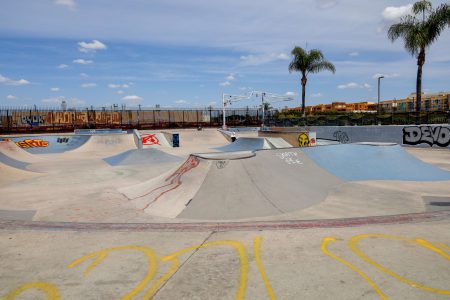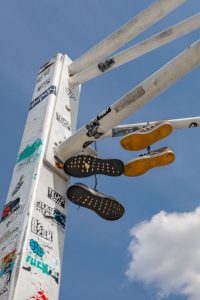
By Tania Rangel
A decade ago, the skatepark at Independence park was filled with 24-hour orange dim lights, electric sockets, and a pay phone that was the hub of illegal transactions. Now, all you see are skaters hanging out and children toppling over when trying to recreate a trick resulting in some scratches, but barely tears. Some time ago this wasn’t the case.
The park was once highly monitored by the police and raised constant concerns about how safe of a designated skating area it was for its visitors. Professional skateboarder Tony Hawk once said, “I won’t quit skating until I am physically unable,” which was somewhat of the case for local Independence Park skaters when their park got taken away. It didn’t stop them from skating, but it did create a barrier in the skate community. They knew that if they wanted to keep their park, they needed to take care of it.
Pro skater and star of the 2011 film, “Dragon Slayer”, Joshua “Skreech” Sandoval, describes the park with great affection and sincerity. When Sandoval was growing up, the Fullerton skatepark just off of West Valencia Drive and Euclid Street helped shape his life. “When they built that skatepark I learned how to skate ramps,” Sandoval said. “I built a career doing so.” But, he got more than just a career out of it. He had also found a one-of-a-kind type of brotherhood, a unique sense of belonging.
However, there was a malicious vibe that would eventually disrupt the skate community’s safe space. After an undercover police investigation, five felons were arrested and were later banned from the park. Due to ongoing acts of illicit activities, the Fullerton skatepark was officially shut down in March 2010.
Drinking was a prevalent problem at the skatepark. Sandoval describes drinking and skating as “ritualistic” to skaters. The locals would hide kegs in the trash can, chug their tall cans as soon as they spotted a cop from a mile away or would even just throw them towards the train tracks. But drinking wasn’t the only illegal activity happening in the park.

Sandoval mentioned that even though police were well aware of the illegal transactions, they had reached their limit once they realized that marijuana wasn’t the only thing being exchanged. Sandoval says that there was a point in which there was a war over who could make the most money through illegal transactions. Outsiders who weren’t considered local skaters would try to seize business from the skaters. The pay phone was the token of the illicit activity. Sandoval and other locals would receive calls in regards to marijuana. An incoming call would typically consist of requesting to speak to someone in particular and they would set up a meetup spot at the park. Sandoval and his friends would simply sell marijuana to support their habits and to buy fast food every now and then.
Sandoval describes police efforts to regulate the park as hopeless. The park’s location allowed locals to see whenever a police car was arriving, Yes, police presence helped stop some illegal activity, but as soon as they drove away it continued. The removal of the pay phone, 24 hour lights that would attract nightlife without surveillance, and the electric sockets that would be used to plug in RV’s, did however help relieve some late night activity according to Sandoval.
“It became unfriendly for the kids to come and play,” John Clements, Fullerton parks and recreation supervisor said. “The adults were taking over the park.”
The Fullerton skatepark was supposed to be closed temporarily, but the closure dragged on for much longer. According to Fullerton City Council documents, it had become a park full of “intimidation and lawlessness.” Fullerton parks and recreation and the Fullerton police department worked relatively closely to help put an end to the illicit activities being committed by some adult skate park users. A 2012 city agenda states that such activities included “illegal drug sales (primarily marijuana); illegal drug usage; alcohol consumption; public urination; graffiti, and; destruction of public property.” Ultimately, the illicit activities led to the park’s closure.
The skatepark was more than just a park to many of the skaters; it was home. Where would they go once their safe place was taken away? Sandoval, who was 24 at the time, got quite creative with his resources. “I would skate abandoned houses, empty swimming pools, we would drain them,” says Sandoval. There were foreclosed houses with pools that Sandoval and his friends would sneak into and drain just to skate. Preston Okard, 20, who has skated at the park for about 10 years, said that his dad and him would simply hop the fence to get into the park. “I was young, just coming with my dad.”
Others would skate at the parking structure next to Fullerton College, which was the original skatepark. It was coined “The Underground” by the Fullerton skaters. The Underground stopped being a designated skating area once the actual park was built. If someone is caught skating at the parking structure, they are prone to receiving a citation. However, that doesn’t stop late night skating sessions from occurring.

The temporary closure of the skate park was just a week, then a month that turned into more than a year, and concerns grew about when the skatepark would reopen. Kids were eager to skate and would sneak in just to do it, which brought officials to rethink the park’s closure. It was time to get it up and running, but according to Clements there was no moving forward unless there was a strategically set plan that would assure the community that things would be kept safe and monitored. The city was working on a master plan during the closure, but mainly due to economic hardships and budgetary constraints it caused a major delay according to the city agenda.
With the efforts of the Fullerton Skate Association, Fullerton Parks and Recreation Department and the Fullerton Police Department, the park reopened on June 16, 2012 under certain conditions. According to records of the Fullerton City Council meeting, the city staff was to meet with the Fullerton SkatePark Ad-Hoc committee to address any concerns and long term planning. They would approve temporary operating hours with review and reports by Parks and Recreation as well as provide volunteers for monitoring. They were to also offer cleaning of the park on a daily basis, weekly graffiti removal plus minor repairs, and approval of development for fencing, lighting, seating, trash receptacles and signage.
“There was a nice core of adults that got together to form an organization called the Fullerton Skaters Association,” says Clements. He explained that in order to keep the park safe there would be a need for mentors that would keep an eye out at the park. The mentors were the skaters themselves. Although police presence seems like the immediate solution, there is much more significance when one of your own is leading you along the way, Clements explains.
There would not be a skate park without the efforts of the local skate community. Local skate companies, Anaheim Skateboards and Scum Skateboards, were the core of the FSA along with local skaters of all ages. They helped paint over the graffitti, monitor the area, and encouraged locals to follow the rules according to Sandoval.
“They’re good people who grew up here and knew how to keep it clean and safe,” Ronnie King, a longtime Fullerton skater, stated in regards to the FSA. “We like having our place, our home. If we don’t have this here, we will have a hard time meeting with everyone.”
That investment from the local community has paid off.
“Nothing is really going on here, nothing bad,” Okard states. “They have no reason to stop by and say anything.” The park has remained safe and open for eight years. The monitoring has become less intense. It’s become simply a skatepark with what it should be filled with—ramps and skaters.
